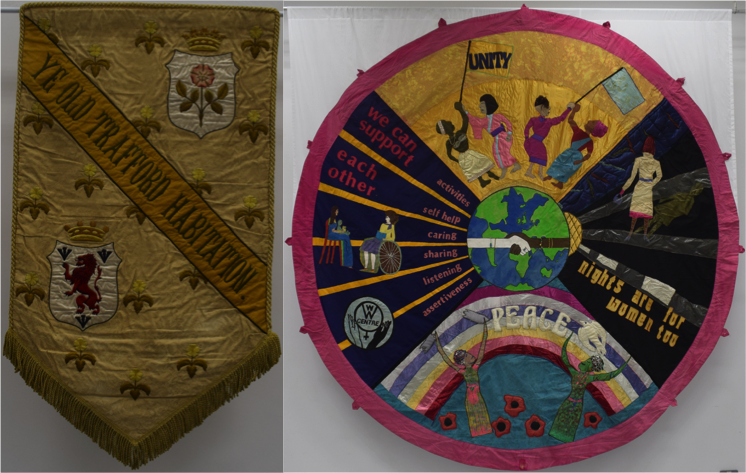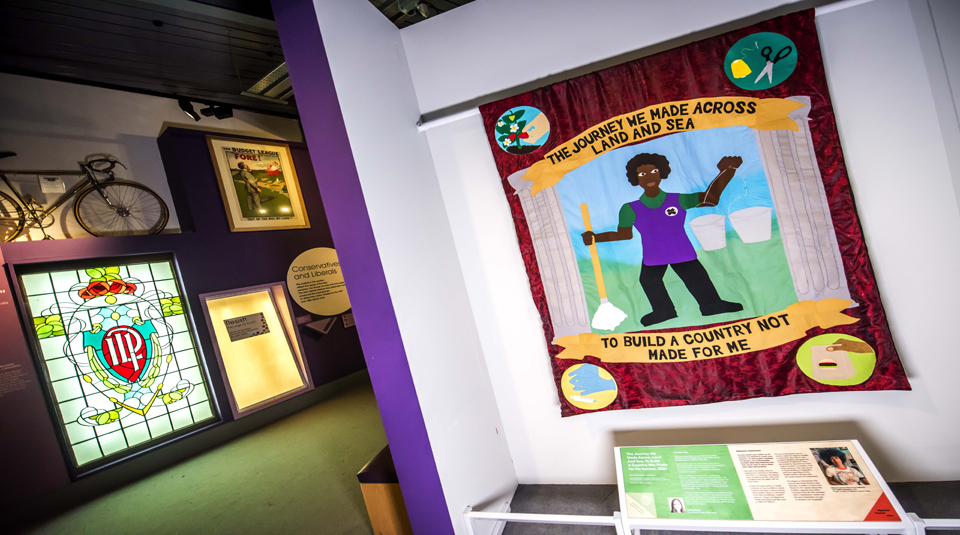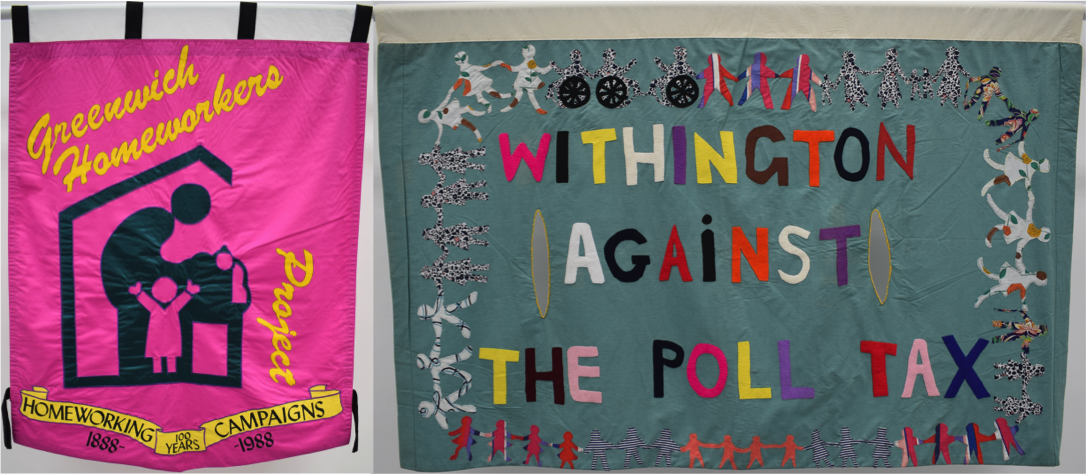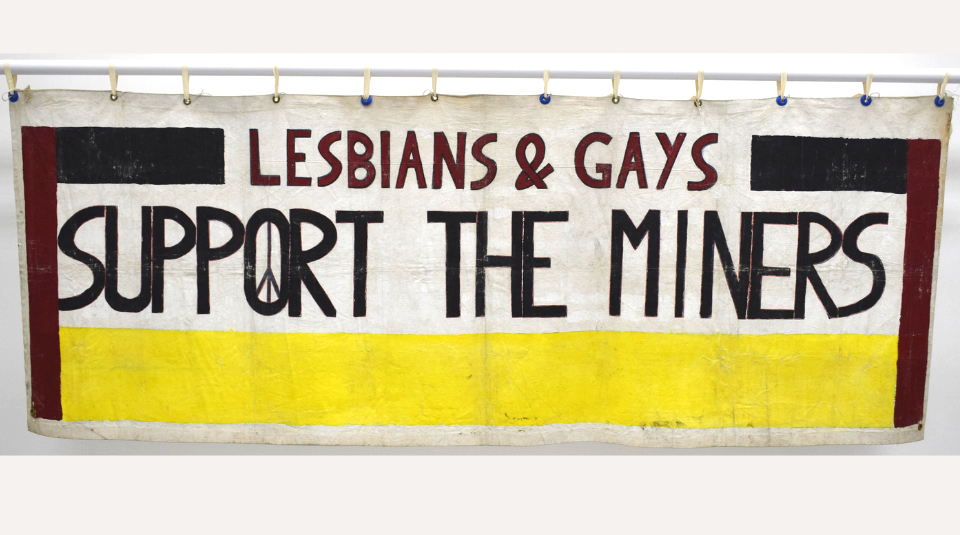


This month 26 beautiful banners will be on display thanks to a new exhibition curated and conserved by the team at People’s History Museum (PHM). In this blog we ask Textile Artist and the maker of one of these works of art, Seleena Laverne Daye about the significance of banners in the fight for change and what visitors can expect from the new 2022 Banner Exhibition as it opens. Book to take a tour of the 2022 Banner Exhibition on Thursday 24 March at 11.00am.

I’m a textile artist whose work is heavily influenced by banner imagery and slogans. I have been inspired many times wandering the galleries looking at the banners, past and present, and the 2022 Banner Exhibition collates all of what inspires me, so well. It’s a wonderful showcase of skill, craftsmanship and community; it highlights the importance of banners.
In this new exhibition at People’s History Museum over two gallery spaces are 26 pieces that have been selected to convey the importance of banners. Featured are banners made over a course of 170 years, dating from the 1850s up to 2021.
There are traditional trade union banners, ones for disabled people’s rights, homelessness and a Left-wing book club. There are banners that protest nuclear war, poll tax and support strikes. There are big slogans and colourful motifs, memorabilia from marches, a snapshot of history, an archive of activism and most importantly a documentation of underrepresented communities fighting for change.
The stories we are often told, the ones shared through mass media, are those of the privileged. The less privileged have to create their own communities, share their own stories, raise their voices louder and banners are a perfect example of that. An image of solidarity, a representation of how and why communities come together to fight for equality and to incite real change.

Walking around the museum and taking in the banners, I did what I always do when looking at art, in particular textile art, which is to get my face as close as allowed to see the handiwork involved in its creation.
But are banners art? Yes, they are a tool for activism and a documentation of the history of rights and equality, but does their practicality take away their artistic merit? I don’t think so, I’m a firm believer of anything that’s been created with love or passion is a work of art and banners are no different.
The breadth of banners in the exhibition means the styles of them vary greatly. Older banners feature more traditional techniques like hand painted silk, highly detailed embroidery and intricate designs where as some of the more modern banners are simpler, more direct and more vivid in design. Even the fabrics used represent the times they are made in, from silks to cheaper and more accessible fabrics like felt and polyester.

Protest banners and placards taken on marches in present day represent how fast paced society has become. A quick marker pen slogan on an old cardboard box, a splash of paint on an old bed sheet, are what are commonplace on the streets today, which means textile banners like those in the exhibition make you even more aware of the amount of time and effort and care has gone in to making them.
Yes, banners are undoubtedly an image of activism, as the exhibition showcases so well, with the inclusion of banners like the Lesbian and Gays Support the Miners, which sees two communities coming together in solidarity for better rights and support for workers.
But they are also undoubtedly works of art, which can easily be seen in banners such as the Ye Olde Habitation, with its exquisite needlework, but also in Blackburn’s Youth Service girls’ group banner for International Women’s Day 1988, a community project made by people who are not always afforded the time and space to create art.
To me that’s what art is, a way for people to express themselves, share their story and evoke feelings and that is what these banners do.

Protests and fighting for equality, whether that’s human, animal or environmental rights is something that is even more prevalent in today’s world, and people have taken to the streets more densely in the past two years then I remember in my 37 years of life. More recently protests to ‘Kill The Bill’ about the Police, Crime, Sentencing and Courts Bill (Policing Bill), which threatens our right to even have our voices heard (amongst other things) means it’s even more important for people to create banners and placards and take to the streets.
Last summer I had the privilege to be able to create a banner for PHM’s new installation Migration: a human story and Migration programme, alongside the Community Programme Team. Despite being inspired by the banners hanging in the galleries, there was something hugely prevalent to myself and this team; the imagery on most of the traditional banners was very ‘British’ and very white. It’s not often as a Person of Colour you see yourself represented in gallery or museum settings, and that was something we wanted to change.
I look forward to seeing the evolution of banner imagery and walking through the galleries you can see how far we have come in terms of the visuals, but it is also a stark reminder how we are still campaigning and fighting for so many of the rights that have been fought for over decades.
Banners act as a reminder of how far we have come and how we have still got work to do. This exhibition shows us we must keep documenting for future generations and using our voice and banners to make the world a better place.
Seleena Laverne Daye is a Textile Artist.
Guest blogs are not curated by PHM but feature voices on topics relevant to the museum’s collection. Guest blogs do not necessarily reflect the views of PHM.
Come along to the new 2022 Banner Exhibition, open until to Sunday 8 January 2023 and browse two floors of galleries – with the banners interspersed throughout – as well as a unique viewing window into the specialist Conservation Studio; where each banner has been expertly cared for prior to hanging.
Visit Migration: a human story until Sunday 24 April 2022. Part of a huge programme of events and exhibitions exploring migration. With support from Art Fund and The Joseph Rowntree Charitable Trust.
Book to take a tour of the 2022 Banner Exhibition with PHM’s Curator Kloe Rumsey and 2022 Programme Office Michael Powell on Thursday 24 March at 11.00am. Limited places.
People’s History Museum is open Wednesday to Sunday from 10.00am to 4.00pm. The museum and its exhibitions are free to visit with a suggested donation of £5. To find out about visiting the museum, its full exhibition and events programme visit phm.org.uk.